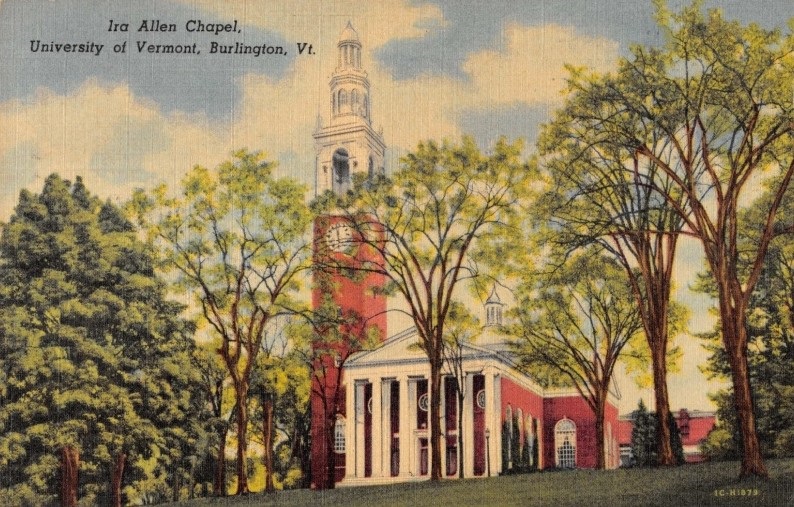
1930's - Chapel exterior (Photograph from an archival source: Vintage postcard, submitted by Jim Stettner/Jim Stettner)
Note: Not extant. Not playable. (in this location)

2021-07-17 - Identified from a post by Peter Rudewicz on Facebook's 'Kimball Pipe Organs'; July 17, 2021. *"Welte-Mignon Opus 211, built for the University of Vermont, holds the distinction of being one of the first and few Welte organs built for academic institutions in the United States. Installed in Ira Allen Chapel, both the organ and chapel were gifts from James B. Wilbur. The University solicited bids from at least four builders: Welte-Mignon, Estey, Moller, and Skinner. Estey was particularly keen to have the contract, since the University was practically in their backyard. Ultimately, the contract was awarded to Welte-Mignon, and the new organ was received with much excitement by the citizens of Burlington."* -Jim Stettner
2021-07-17 - The Pedal division has no idependent registers, but is rather comprised of borrows and extensions from manual ranks. -Jim Stettner
2021-07-17 - From Wikipedia: The original organ installed in the Ira Allen Chapel was a three-manual, electro-pneumatic Welte-Mignon Philharmonic Pipe Organ. The manual compass was CC to C4 (61 notes). The pedal compass was CCC to G (32 notes). The wind chests of the manuals featured superoctave couplers (4'), which extended the compass of the keyboards to 73 notes. There was also installed a reproducing console, which played recorded rolls in detail utilizing pedals, swells, and tempo characteristics of renown organists.[5] During the chapel's dedication ceremony of 14 January 1927, the organ was played by Dr. T. Tertius Noble, the organist of St. Thomas' Church of New York, who concluded the event with two organ recitals composed of classical pieces, and an original piece that was said to have demonstrated the capabilities of the instrument.[29] "The work was a study in harmony and scanty use of solo stops. A few arpeggios with the harp stop were most effectively used." — Vermont Alumni Weekly, January 1927 In 1985, the pipe organ was removed due to building renovations requiring the installation of a new airshaft in place of the organ's pipes. The installation of a new pipe organ was estimated to cost in the millions of dollars, and was further anticipated to have complications due to the effect of varying temperature and humidity on the organ's intonation system. The prospect was thus determined to be cost-prohibitive. However, in August 2004, a new Rogers Trillium 3 digital electronic organ was installed (costing about $100,000).[30] Organ enthusiasts have argued against the authenticity of the digitally re-created pipe organ sound.[31] -Jim Stettner
2024-07-11 - The organ is extant in its entirety, and currently in storage. Rudewicz & Company, Inc. removed the organ from a University of Vermont storage facility in 2019. Information received online from Peter Rudewicz on 2024-07-10 -Paul R. Marchesano
Regrettably, it is not possible to display the information about the sponsor of this pipeorgandatabase entry or if there is a sponsor. Please see About Sponsors on Pipe Organ Database.